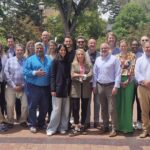By Chuks Oyema-Aziken and Felix Khanoba
Stakeholders gathered in Abuja on Wednesday to deliberate on a pilot project aimed at addressing the persistent water scarcity in Wamako and its surrounding areas in Sokoto State.
This initiative was the focus of the National Validation workshop, where reports from two consultants on legal/policy and communication strategies were reviewed.
Engr. Clement Nze, Director General of the Nigeria Hydrological Services Agency (NIHSA), highlighted the project’s potential to significantly improve water supply in the region.
The project, titled “Improving Integrated Water Resources Management, Knowledge-Based Management and Governance of the Niger Basin and the Iullemeden-Taoudeni/Tanezrouft Aquifer System,” is a response to the adverse effects of climate change on both underground and surface water resources in Sokoto basin, especially in Wamako.

Represented by Mr. Stephen Jabo, Director of the Department of HydroPhysics at NIHSA, Engr. Nze explained that the project aims to restore the water balance and sustainability in Wamako through various intervention measures.
These efforts are part of a broader initiative involving 11 countries, including Algeria, Benin, Burkina Faso, Chad, Cameroon, Côte d’Ivoire, Guinea, Nigeria, Niger, Mali, and Mauritania, each addressing specific water-related challenges.
He said Wamako was selected for this pilot project due to the observed decline in water levels in the Sokoto River, which now only flows during the rainy season, significantly affecting agricultural and human activities.
“Ideally, this has been a river that is perennial in nature over the years but suddenly due to impact of climate change. And human activity as affected this water resources. Even the groundwater has also been affected hand-dug wells and shallow boreholes have also dried up.
“Therefore, the pilot project covers four thematic areas of the main project, which are number one, efficient groundwater management number two, establish and mitigate various sources of pollution within the area. And then adaptation to climate extremes. And lastly, integrated management and planning for conjunctive use of both surface water and groundwater resources with a view to ensure sustainability of groundwater,” he said.
The pilot project encompasses four key areas: efficient groundwater management, pollution mitigation, adaptation to climate extremes, and integrated management and planning for the conjunctive use of surface and groundwater resources to ensure sustainability.
Nze said NIHSA, responsible for assessing and managing Nigeria’s water resources, has been implementing the project under the central coordination of the Sahara and Sahel Observatory (SOS) in Tunisia.
The project is primarily funded by the Global Environment Facility (GEF) and addresses both surface and groundwater resources.
“The Niger Basin project focuses on the River Niger, the largest transboundary river in Nigeria, and has identified specific water resource problems in the Sokoto River Basin,” Nze added.
Dr. Thomas Adebayo, Communication Consultant for the project, emphasized the importance of communication in the project’s implementation, particularly in addressing water quality issues.
He noted that activities such as borehole drilling, agricultural practices, drainage patterns, and waste disposal in Sokoto, Katsina, and surrounding areas contribute to water quality degradation.
Adebayo advocated for legal frameworks to facilitate a feedback system, which would help regulate borehole drilling and prioritize water use.
“Effective communication is crucial for informing communities, stakeholders, and the government about processes that affect water quality and ensuring that water quality is maintained,” he said.
Adebayo posited that the project represents a significant step towards ensuring sustainable water management in Wamako and the wider Sokoto basin as well as addressing the pressing water resource challenges exacerbated by climate change and human activities.
The first day of the two-day workshop saw participation from the Ministry of Water Resources, the Ministry of Agriculture, scholars, and other stakeholders.
It also featured paper presentations by resource persons, discussions, synthesis and recommendations.



